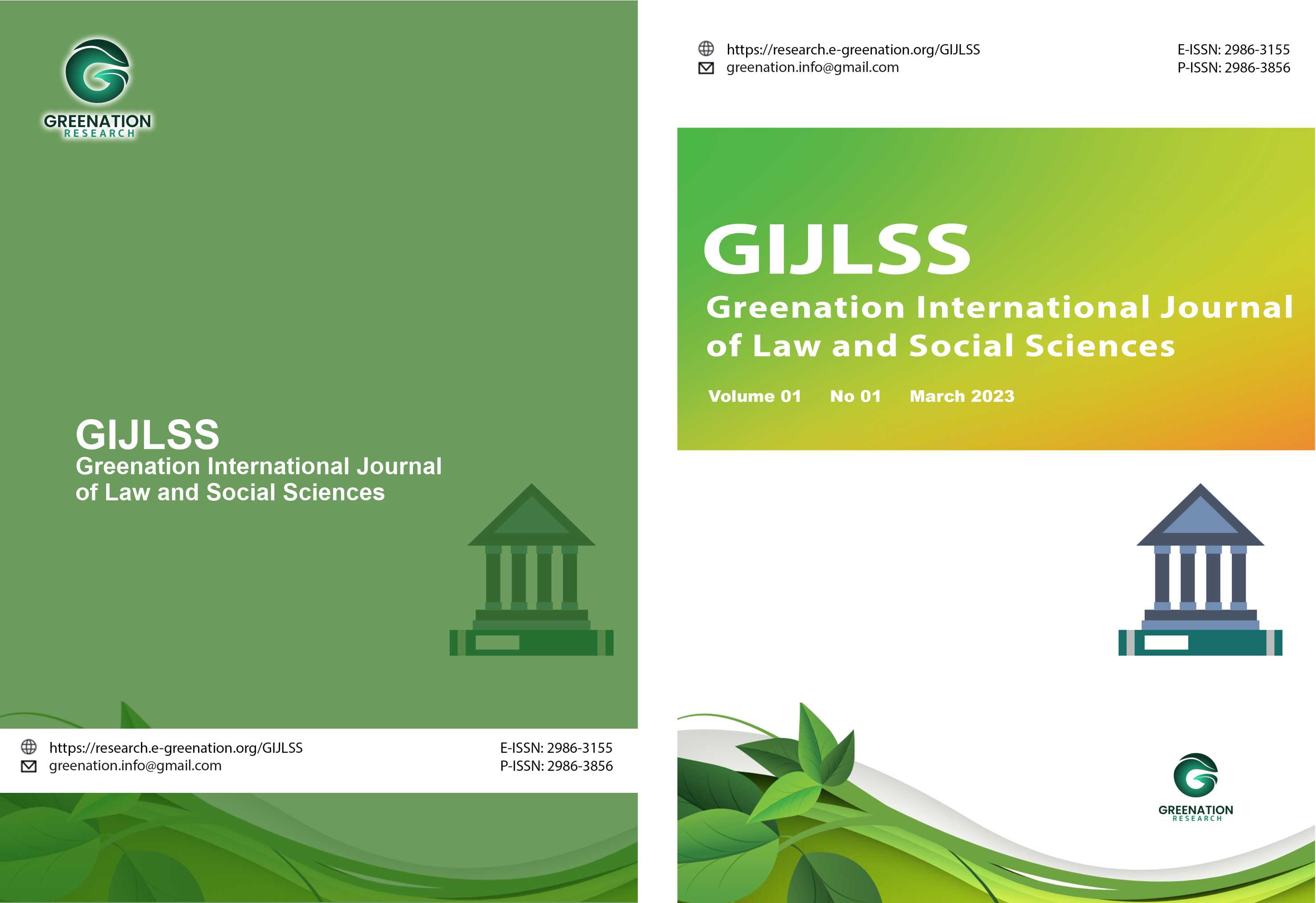Cooperation Employee Performance: The Effect Factors and Implication
DOI:
https://doi.org/10.38035/gijlss.v1i3.126Keywords:
Leadership, Compensation, Motivation, Cooperation Employee PerformanceAbstract
In this investigation, we aimed to analyze how leadership and compensation influence motivation and ultimately impact the job performance of Cooperation in Padang. To achieve this goal, we utilized a descriptive-verificative research approach through surveys completed by 330 Cooperation employees. Our data was analyzed using the Linear Structural Relationship (LISREL) 8.80 program that employed the Structural Equation Model (SEM). The findings of this study revealed that both compensation and leadership positively contribute to motivation, which in return, plays a critical role in advancing employee performance. Significantly, both compensation and leadership, along with motivation, were found to have a considerable positive effect on staff members' performance. The motivation variable came out on top as the most dominant influence on performance, with compensation leading the way as the most influential variable on motivation. The findings suggest that to enhance employee performance in the Cooperation in Padang district, there needs to be a focus on nurturing employee motivation in the Cooperation in Padang regency. This can be achieved by placing importance on developing strong relationships with members and co-workers, which was highlighted as the key factor in boosting motivation levels. As a result of this research, managers should consider prioritizing strategies that foster healthy work relationships to improve overall performance.
References
Ali, H., Sastrodiharjo, I., & Saputra, F. (2022). Measurement of Organizational Citizenship Behavior: Workload, Work Culture and Motivation (Literature Review Study). Journal of Multidisciplinary Science, 1(1), 83–93.
Baird, C. H., & Parasnis, G. (2011). From social media to social customer relationship management. Strategy & Leadership, 39(5), 30–37. https://doi.org/10.1108/10878571111161507
Beth Knight. (2016). Competency Model for HR Professionals. Intelligence. Retrieved from http://www.cisl.cam.ac.uk/graduate-study/master-of-studies-in-sustainability-leadership/pdfs/a-behavioural-competency-model-for-sustainability.pdf
Chong, D., & Ali, H. (2022). LITERATURE REVIEW?: COMPETITIVE STRATEGY , COMPETITIVE ADVANTAGES , AND MARKETING PERFORMANCE ON E-COMMERCE SHOPEE INDONESIA. Dinasti International Journal of Digital Business Management, 3(2), 299–309.
Crane, A. D., Michenaud, S., & Weston, J. P. (2016). The Effect of Institutional Ownership on Payout Policy: Evidence from Index Thresholds. In Review of Financial Studies. https://doi.org/10.1093/rfs/hhw012
Grant, A. M. (2012). Leading with meaning: Beneficiary contact, prosocial impact, and the performance effects of transformational leadership. Academy of Management Journal, 55(2), 458–476. https://doi.org/10.5465/amj.2010.0588
Gula, R. (2008). Legal protection of wolves in Poland: Implications for the status of the wolf population. European Journal of Wildlife Research. https://doi.org/10.1007/s10344-007-0129-8
Hameed, A., Ramzan, M., Hafiz, M., Kashif Zubair, M., Ali, G., & Arslan, M. (2014). Impact of compensation on employee performance. International Journal of Business and Social Science, 5(2), 302–309.
Harahap, E. H., & Ali, H. (2020). MANAGERIAL PERFORMANCE MODEL THROUGH DECISION MAKING AND EMOTIONAL INTELLIGENCE IN PALUTA DISTRICT. Dinasti International Journal of Economics, Finance & Accounting, 1(2), 358–372. https://doi.org/10.38035/DIJEFA
Heller Baird, C., & Parasnis, G. (2011). From social media to social customer relationship management. Strategy & Leadership, 39(5), 30–37. https://doi.org/10.1108/10878571111161507
Hirshleifer, D., & Teoh, S. H. (2003). Limited attention, information disclosure, and financial reporting. Journal of Accounting and Economics. https://doi.org/10.1016/j.jacceco.2003.10.002
Ittner, C. D., Larcker, D. F., & Meyer, M. W. (2003). Subjectivity and the weighting of performance measures: Evidence from a balanced scorecard. Accounting Review. https://doi.org/10.2308/accr.2003.78.3.725
Joo, B. (Brian), & Ready, K. J. (2012). Career satisfaction. Career Development International, 17(3), 276–295. https://doi.org/10.1108/13620431211241090
Kamisah, A. L. (2012). A Study on Stress Among Customer Service Officer and Executives in Central Region, Employees Provident Fund. Universiti Utara Malaysia. Retrieved from http://etd.uum.edu.my/3016/
Kasman, P. S. P., & Ali, H. (2022). LITERATURE REVIEW FACTORS AFFECTING DECISION MAKING AND CAREER PLANNING?: ENVIRONMENT , EXPERIENCE AND SKILL. Dinasti International Journal of Digital Business Management, 3(2), 219–231.
Kholisoh, N., & Ali, H. (2020). Shaping radical attitudes: Mass media and government policies analysis (case study in high school students of West Jakarta). Talent Development and Excellence.
Kotabe, M., & Murray, J. Y. (2004). Global sourcing strategy and sustainable competitive advantage. Industrial Marketing Management. https://doi.org/10.1016/j.indmarman.2003.08.004
Kurtessis, J. N., Eisenberger, R., Ford, M. T., Buffardi, L. C., Stewart, K. A., & Adis, C. S. (2015). Perceived Organizational Support. Journal of Management, (March), 014920631557555. https://doi.org/10.1177/0149206315575554
Maida, M. T., Riyanto, S., & Ali, H. (2017). Effect of Job Satisfaction and Leadership Style towards Employee Productivity at PT. Asuransi Umum Bumiputera Muda 1967. Saudi Journal of Business and …, 2(3A), 157–168. https://doi.org/10.21276/sjbms.2017.2.3.7
Malär, L., Nyffenegger, B., Krohmer, H., & Hoyer, W. D. (2012). Implementing an intended brand personality: A dyadic perspective. Journal of the Academy of Marketing Science. https://doi.org/10.1007/s11747-011-0251-8
Mintrom, M., & Norman, P. (2009). Policy entrepreneurship and policy change. Policy Studies Journal. https://doi.org/10.1111/j.1541-0072.2009.00329.x
Mukhtar, Risnita, Saifillah, M. S., & Ali, H. (2016). Effect of knowledge management and work commitment to employees satisfaction services (Study on teacher Madrasah Aliyah Country Jambi Province). International Journal of Economic Research.
Murphy, L., Benckendorff, P., & Moscardo, G. (2007). Destination Brand Personality: Visitor Perceptions of a Regional Tourism Destination. Tourism Analysis. https://doi.org/10.3727/108354207783227948
Platis, C., Reklitis, P., & Zimeras, S. (2015). Relation between Job Satisfaction and Job Performance in Healthcare Services. Procedia - Social and Behavioral Sciences. https://doi.org/10.1016/j.sbspro.2015.01.1226.
Putra, R., & Ali, H. (2022). ORGANIZATIONAL BEHAVIOR DETERMINATION AND DECISION MAKING: ANALYSIS OF SKILLS, MOTIVATION AND COMMUNICATION (LITERATURE REVIEW OF HUMAN RESOURCE MANAGEMENT). Dinasti International Journal of Digital Business Management, 3(3), 420–431.
Sari, D. P., & Ali, H. (2022). LITERATURE REVIEW MEASUREMENT MODEL OF INDIVIDUAL BEHAVIOR AND ORGANIZATIONAL CITIZENSHIP BEHAVIOR?: INDIVIDUAL CHARACTERISTICS , WORK CULTURE AND WORKLOAD. Dinasti International Journal of Management Science, 3(4), 647–656.
Shahzadi, I., Javed, A., Pirzada, S. S., Nasreen, S., & Khanam, F. (2014). Impact of Employee Motivation on Employee Performance. European Journal of Business and ManagementOnline), 6(23), 2222–2839.
Sharma, A. (2009). Implementing Balance Scorecard for Performance Measurement. ICFAI Journal of Business Strategy.
Singh, J. K. (2013). Study of Employees ’ Job Satisfaction and Its. Study of Employees ’ Job Satisfaction and Its, 1(4), 105–111. Retrieved from http://mujournal.mewaruniversity.in/JIR 1-4/13.pdf
Stello, C. M. (2014). Herzberg’s Two-Factor Theory of Job Satisfaction: An Integrative Literature Review. Herzberg’s Two-Factor Theory of Job Satisfaction, 32. https://doi.org/10.7537/marslsj140517.03.Keywords
Style, L., & Performance, E. (2015). Arabian Journal of Business and. Arabian Journal of Business and Management Review, 5(5), 1–6. https://doi.org/10.4172/2223-5833.1000146
Sutanto, E. M., & Kurniawan, M. (2016). The impact of recruitment, employee retention and labor relations to employee performance on batik industry in Solo city, Indonesia. International Journal of Business and Society, 17(2), 375–390.
Sutiksno, S. D. U., Rufaidah, P., Ali, H., & Souisa, W. (2017). A Literature Review of Strategic Marketing and The Resource Based View of The Firm. Int. J. Econ. Res, 14(8), 59–73.
Telha, A., Rodrigues, A., Páscoa, C., & Tribolet, J. (2016). The Competency Architecture as Error Limiting Element and Efficiency Enhancer in Business Processes. In Procedia Computer Science (Vol. 100, pp. 665–670). https://doi.org/10.1016/j.procs.2016.09.209
Webb, J. W., Bruton, G. D., Tihanyi, L., & Ireland, R. D. (2013). Research on entrepreneurship in the informal economy: Framing a research agenda. Journal of Business Venturing. https://doi.org/10.1016/j.jbusvent.2012.05.003
Downloads
Published
How to Cite
Issue
Section
License
Copyright (c) 2023 Ahmad Quraisy, Thalita Syifa Fatimah, Muhammad Millah Irsyaddin

This work is licensed under a Creative Commons Attribution 4.0 International License.
Copyright :
Authors who publish their manuscripts in this journal agree to the following conditions:
- Copyright in each article belongs to the author.
- The author acknowledges that the Greenation International Journal of Law and Social Sciences (GIJLSS) has the right to be the first to publish under a Creative Commons Attribution 4.0 International license (Attribution 4.0 International CC BY 4.0).
- Authors can submit articles separately, arrange the non-exclusive distribution of manuscripts that have been published in this journal to other versions (for example, sent to the author's institutional repository, publication in a book, etc.), by acknowledging that the manuscript has been published for the first time at GIJLSS.
























